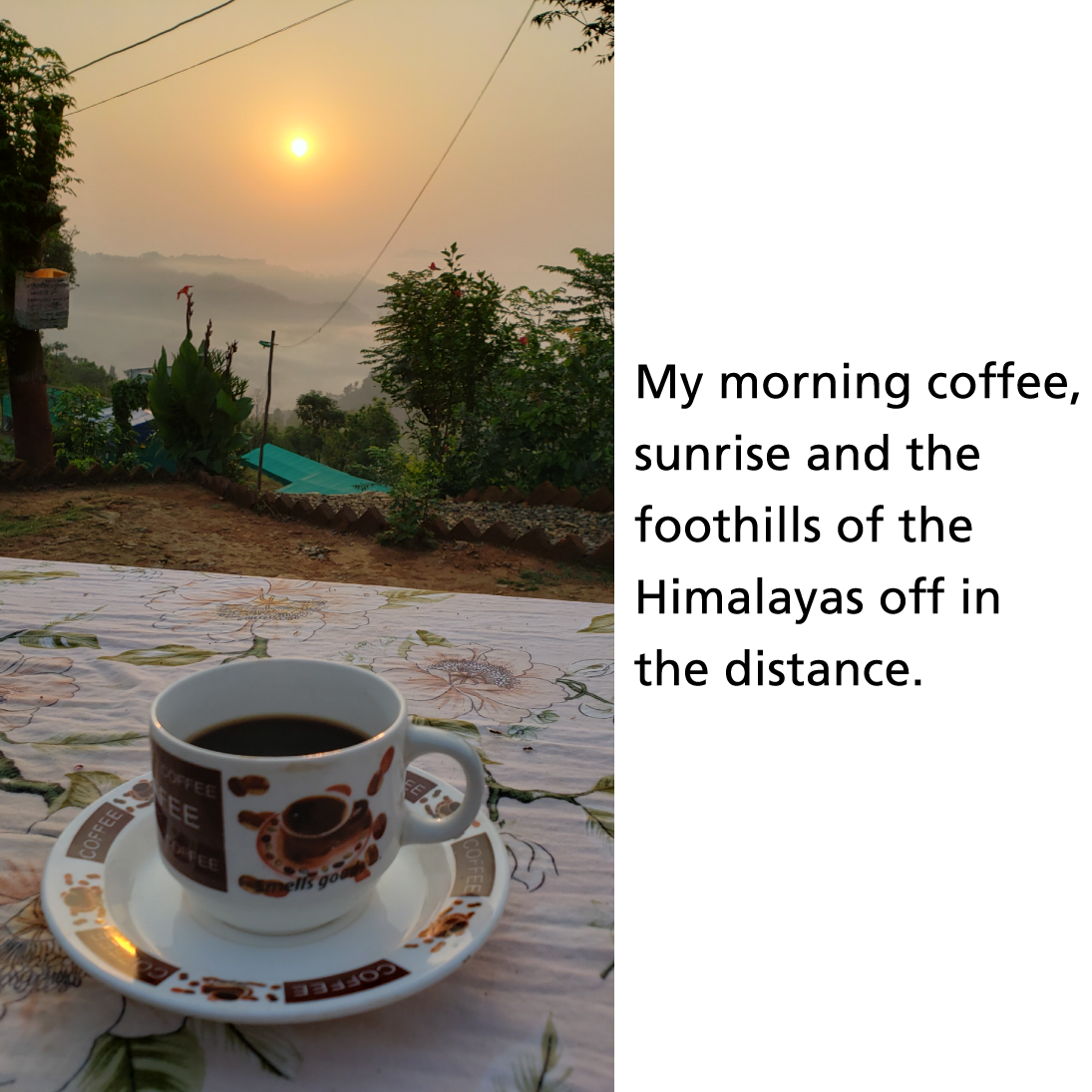
Adventures In Coffee Quality
By: CQI Consultant Todd Arnette, Academy of Coffee Excellence
In my years since becoming a Q Grader and Q Instructor for Coffee Quality Institute (CQI) I have had the great fortune to travel the world’s countries and cultures. A common thread among all is a simple cup of coffee. Most recently it has been my honor to assist CQI on a field assignment in Nepal, part of Lutheran World Relief’s Coffee Support Project in Western Nepal.
 When people are asked to think about Nepal, they tend to think of Sagarmatha (Mt. Everest), adventure & ecotourism in the Himalayas, Sherpas, and cashmere wool. They may recall the devastating 7.8 on the Richter scale earthquake of 2015 that killed 9,000, injured 22,000, and destroyed much of the region’s infrastructure. Some have rebuilt; however, many are still trying to rebuild, and other places are still abandoned and untouched.
When people are asked to think about Nepal, they tend to think of Sagarmatha (Mt. Everest), adventure & ecotourism in the Himalayas, Sherpas, and cashmere wool. They may recall the devastating 7.8 on the Richter scale earthquake of 2015 that killed 9,000, injured 22,000, and destroyed much of the region’s infrastructure. Some have rebuilt; however, many are still trying to rebuild, and other places are still abandoned and untouched.
Rarely do people (even coffee people) think of a nascent domestic coffee sector actively seeking transformation and development. And here is where a coffee opportunity of a lifetime presents itself.
Last year, the Nepal coffee sector produced 513 metric tons, or approximately 31 containers, of coffee. In Nepal 42 of the 77 districts grow coffee, 25 commercially. Definitions of a smallholder farmer vary throughout our industry but are generally considered a farmer living and working on the same piece of land, with the primary labor force being the immediate family. The amounts of land tended may be approximately 2+ hectares, which you can visualize as 2 football or soccer fields.
 In Nepal, the coffee farms are referred to as coffee gardens and the land tended is measured in units called a Ropani, with 20 Ropani per hectare. The average Nepali coffee grower tends only a couple Ropani. At 5,500 square feet, the Academy of Coffee Excellence’s training lab in Williamsburg, Virginia, is a bit larger than 1 Ropani. Let this data sink in … Bourbon varietal, broadly stated, can have 3,000 - 4,000 trees per hectare (https://varieties.worldcoffeeresearch.org/). That is 150 to 200 per Ropani. As a very general guide, a productive coffee tree can yield approximately 1 kg of coffee beans in parchment annually. This means that the average Nepali grower yields 240+/- kg, or 4 sacks of green coffee, per year.
In Nepal, the coffee farms are referred to as coffee gardens and the land tended is measured in units called a Ropani, with 20 Ropani per hectare. The average Nepali coffee grower tends only a couple Ropani. At 5,500 square feet, the Academy of Coffee Excellence’s training lab in Williamsburg, Virginia, is a bit larger than 1 Ropani. Let this data sink in … Bourbon varietal, broadly stated, can have 3,000 - 4,000 trees per hectare (https://varieties.worldcoffeeresearch.org/). That is 150 to 200 per Ropani. As a very general guide, a productive coffee tree can yield approximately 1 kg of coffee beans in parchment annually. This means that the average Nepali grower yields 240+/- kg, or 4 sacks of green coffee, per year.
The purpose of my visit to Nepal was to explore ways of developing and changing the domestic coffee sector from within. The National Tea & Coffee Development Board (NT&CDB) believes that in 5 years’ time, coffee production can be 2,000 metric tons, with the majority remaining as domestic consumption. According to the NT&CDB the domestic coffee sector is dynamic and currently consumes almost 65% of the coffee produced. The NT&CDB is projecting rapid growth of the domestic demand for the next 5 years.
 The Director (Deepak Khanal standing on my left) sees the need to increase the quality and the capacity of production. More importantly, he sees the need to critically assess it first. This is where the Academy of Coffee Excellence with our global network can add value to Nepal.
The Director (Deepak Khanal standing on my left) sees the need to increase the quality and the capacity of production. More importantly, he sees the need to critically assess it first. This is where the Academy of Coffee Excellence with our global network can add value to Nepal.
For my assignment in Nepal, I was asked by CQI to develop and lead cupping, roasting, and brewing workshops and assess outlets for coffee. After this assignment, I was also able to inspect gardens and pulping stations in Gorkha and Kaski districts with the Nepal Coffee Federation as my host.
Cupping Workshop

 I was surprised to learn that very few wet mills cup coffee. Of the 28 people in my cupping workshop, 4 had cupped before. However, by day 2 of 3, the attendees were already on cupping autopilot, correctly setting up, weighing, grinding, pouring, and adhering to protocol.
I was surprised to learn that very few wet mills cup coffee. Of the 28 people in my cupping workshop, 4 had cupped before. However, by day 2 of 3, the attendees were already on cupping autopilot, correctly setting up, weighing, grinding, pouring, and adhering to protocol.
It was a treat to see the connections being made between the cuppers during calibration when they realized they had written coffee descriptors that were consistent with their colleagues’ experiences.
Roasting Workshop

 In my experience, the predominant roast profile in Kathmandu is a dark roast. The only roast training available is YouTube videos and mimicking the end color of international brands' espressos. The roasting workshop focused on cupping profiles that have been modulated slightly in the Maillard reactions zone, with a second round on modulated profiles in the caramelization zone. This proved to be a very enlightening experience for the attendees.
In my experience, the predominant roast profile in Kathmandu is a dark roast. The only roast training available is YouTube videos and mimicking the end color of international brands' espressos. The roasting workshop focused on cupping profiles that have been modulated slightly in the Maillard reactions zone, with a second round on modulated profiles in the caramelization zone. This proved to be a very enlightening experience for the attendees.
Brewing Workshop
 Like many countries, in Nepal the volume of espresso and espresso beverages greatly exceed hand-pour and filter drip coffees. Hand-pour coffee is available, but hard to find. The barista skills that I witnessed ran the spectrum from outstanding preparation and service, to “please stop torturing that poor milk.” The vast majority cared deeply about service and hospitality. The look and feel of the cafés were welcoming and the beverages prepared well.
Like many countries, in Nepal the volume of espresso and espresso beverages greatly exceed hand-pour and filter drip coffees. Hand-pour coffee is available, but hard to find. The barista skills that I witnessed ran the spectrum from outstanding preparation and service, to “please stop torturing that poor milk.” The vast majority cared deeply about service and hospitality. The look and feel of the cafés were welcoming and the beverages prepared well.

On the last day of my trip I was asked to come to the NT&CDB to meet with Director Khanal and discuss the current domestic coffee sector and my professional opinions of it. I started with the good news. In an official cupping with the Nepal Coffee Federation, coffees ranged from 81.00 to 85.75 quality points. Nepal clearly has the ability to produce specialty-grade and Q Grade coffee.
In order to expand the production capacity of Nepal and provide for the projected demand, research and industry best practices are required. This could take the form of expanding the portfolio of varietals and flavors available from Nepal coffee, introducing a diversity of roast and brew profiles that will appeal to an even broader base of consumers, and coffee training at all points in the coffee value chain. Some of the areas I highlighted in my discussion with the NT&CDB were:
- #CoffeeMaMahila (Women In Coffee). The best way to improve the quality of the coffee currently growing is to focus on the beginning of the supply chain. In Nepal, women perform most of the picking and the sorting operations. Investment in continuous quality training regarding picking selectivity, green coffee grading, cleaning, and sorting should yield tangible results in the next harvest.
- If Cupping are the words of specialty coffee, then Green Grading are the letters*. (*Rob Stephen). Investment in continuous quality training regarding green grading, cupping, and defect identification at the garden, co-op, and washing stations should yield consistent incremental improvements as issues are found, the causes determined, and the issues corrected for the next and future crop cycles.
- It is not the drop temperature or the color, but the pathway to it. There is a thirst for roasting knowledge. A few of the roasters that I spoke to had questions that ran the gamut of “how should I store my green?” to “how long will roasted stay fresh?” Currently, roaster training is something only seen on the internet. Training that focuses on the bedrock principles of roasting is a prerequisite to profile roasting, quality control, and product development.
- Where coffee meets the consumer. The use of multiple brew methodologies: full immersion, pour-over, vacuum, pressure, and batch filter help the end consumer to know by taste how different a coffee can be. Many of the baristas that I spoke to had questions about brew ratios, appropriate grind particle sizes, and proper operation of the brew devices. Here too, the internet is the primary educational resource.
- If we build it, they will come. The coffee community in Nepal has demonstrated a thirst for education. If that education is to carry the imprimatur of the Nepal Coffee Federation or the National Tea and Coffee Development Board then that education must be: researched, documented, footnoted, science based and advancing Industry Best Practices.
 How often do you get an opportunity to be a part of a nation’s transformation of their coffee sector? Nepal has a thirst for in-person coffee education spanning every point in the supply chain. Some are ready for officially credentialed programs like the ones that CQI offers and others need fo
How often do you get an opportunity to be a part of a nation’s transformation of their coffee sector? Nepal has a thirst for in-person coffee education spanning every point in the supply chain. Some are ready for officially credentialed programs like the ones that CQI offers and others need fo undational principles and fundamental basics.
undational principles and fundamental basics.
 I will be returning to Nepal. If you are a coffee professional with skills to share, perhaps you should come with me.
I will be returning to Nepal. If you are a coffee professional with skills to share, perhaps you should come with me.

5 comments
hfuEUCMWeRYXmKT
hBQRzColOIAxk
XAhqScOHZoxY
AIgunPXBYqR
Thanks for this informative article.Would love if you come to Uganda.We have the best coffee grown in the best climate.